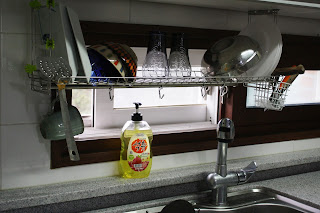When I went to his shop 2 years ago (see gory details here) with my first beloved TA, I was still a cowering American, not yet owning the full Authority of my Professorship and trying overly hard not to offend the natives. This time, however, armed with my current beloved TA, a just-completed make-over at a pricey department store (blog to follow), a fancy English/Korean business card, and a far more
Visit 1: Camera Drop Off
We walked into the little shop and I explained the SD card reader problem with my camera, speaking directly to Camera Man’s face (he’s older than me, so this was a bit rude), waiting for my TA to translate. He looked at my camera and made some notes in a ratty spiral-bound notebook on the counter. Figuring he'd need my name and phone number, I slapped down my business card, Korean side up. The word “kyo-soo-neem,” written right under my name, means something like Fear Me for My Professorship Trumps Whatever Puny Job You Have. Camera man offered eyebrow flashes at this. I felt I had scored a teeny tiny hit. Then, seeing that I teach psychology, he quickly countered with a request to analyze him (ooh - good play, camera man). I, not in the mood to explain the difference between the psychological domains of therapy (not me) and teaching/research (me), just stuck with something safe: You are a happy man. More! he wanted. No, I said (saying “no” in Korea, especially to someone older, is pretty rude. But probably not as rude as what I really wanted to say.). Then he, in a crafty move, wanted to analyze me. And he did: Very beautiful! he said. Ha, I thought to myself. Last time I was here you told my TA that I was fat. In my mental scorebook, we were tied at this point.
He fussed with my camera, writing more cryptic notes. After an elaborate show of looking all over the camera, shaking his head and making little grunty noises (he’s not your more subtle actor), he confided in my TA that I had worn off the camera’s serial number; indeed, a more responsible camera owner would have protected this vital information with scotch tape (which, in Korean, sounds like suh-kawch-uh tay-puh). Not a bit deterred by his shaming attempts, I offered to text him the serial number once I got home. No, no, he replied. Ha, ha -- I don’t really need it. Harrumph. He then fussed about the purple scarf I use instead of the
It was his move. He solidly tap tap tapped on my lens filter, eyebrows raised. Plastic! he chortled disparagingly, taking my filter off and flipping a brand new glass filter next to it onto the counter. I stared into his tiny eyes, my face a mask of deadly self-control. You, I said slowly, sold me that plastic filter two years ago. Oh! he responded. Ha ha--glass filter is much better! And he placed my plastic and his glass filter on some newspaper as if that would prove some superior quality. Ah, I said, pretending to consider this option. I looked at him. Is it free? Oh! No, no! Ha ha, he said, it’s 30,000 (roughly $25). Ah. Not free? Then no. Plastic is fine, I said. I might have gained some ground here, as he silently cleaned my filter and replaced it on the lens.
So after this 20-some minutes of fussing and banter, he finally said he’d send the camera out for a repair estimate and would text my TA in 3-4 days. Fine. Today, I did not lose. I stood up to Camera Man.
Intermission: The Negotiation
My TA heard nothing for 6 days, then she learned that the camera was repaired (!) and ready for pickup. Those unauthorized repairs would cost 150,000won (about $128). Tap tap tap, I thought. How to counter this move? Google showed I could get this same repair for $85 in the US, so I instructed my TA to negotiate: because he had not been authorized to go ahead with the repair, I would not pay more than 120,000 won (about $100). To my surprise, he agreed. This was unsettling.
Visit 2: Camera Pick-up
I returned to the shop without my TA, feeling confident that I could manage the exchange of repaired camera for payment. He remembered me, got my lens-less camera out of a ziplock bag, and began playing with its buttons. After several minutes of his fiddling silence and consultation with a computer, I realized he was setting the date on the camera. Surely that could have been done earlier? That done, he grabbed a lens from his stock, clicked it into place, and took a couple of test pictures. (Surely this could also have been done earlier, right?) Apparently satisfied, he removed his lens and handed the camera over to me. Where is my lens? I asked. You have? he asked, pointing at me with raised eyebrows. No. I do not. You have it, I said, pointing at him (a little rudely). Oh, he said. Ha ha. He rummaged extravagantly about and found my lens, clicking it into place. I did some test shots of my own to confirm that the camera worked and it was time to finish this distasteful business.
I pushed my Korean bank card across the counter to him. No, no, he said. Korean money! I slowly stretched my hand over that thick glass counter: Tap Tap Tap! This is HanaBank – Korean! Oh! Ha ha, he said. He rang up the sale: 132,000 won. No, I said. 120,000 won. Oh! he exclaimed. It's 120,000 won for repair plus 12,000 for…something. I could not understand him; I could not understand the tiny Korean print on the receipt. I was trapped. Frustrated. Outplayed. AGAIN. By the camera weasel.














































